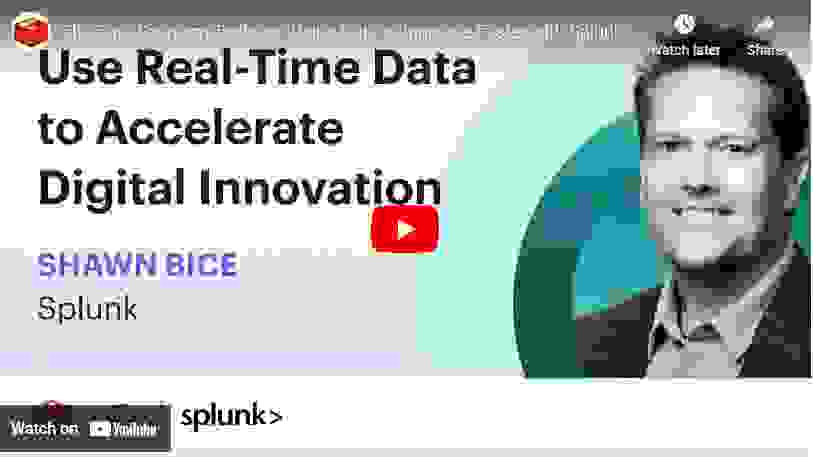
Learn more

The Data Economyis a video podcast series about leaders who use data to make positive impacts on their business, customers, and the world. To see all current episodes, explore the podcast episodes library below.
What will be different about IT and data in the years ahead? The simple answer is speed.
Business leaders are challenging their IT and technology teams to release mission-critical applications and data service MVPs faster than ever before. And the pace and expectations are only going to accelerate.
Shawn Bice, President of Products and Technology at Splunk, believes this accelerated pace will drive businesses to respond to their customer base in near real-time. In this episode of the Data Economy podcast, Shawn explains why he thinks real-time data will play a more prominent role for organizations that want to serve their customers better and compete in the years ahead.
Here’s how Shawn contextualizes just how far data technology has come in the past 50 years: “From pretty much 1970 almost all the way up to the year 2000, most people would have built an application on a relational database system. Today, there are over 350 different systems tracked by DB engines. What’s happened is we used to have this one-size-fits-all database for almost three decades, and today it’s really these purpose-built systems that are very specialized for a given access pattern. That’s the world we’re in now.”
It is quite remarkable to think about this shift and how huge the technology aspects of this change are, especially in competitive industries. We’re in a time when real-time data platforms are a source of differentiation for organizations of all sizes, and latency is the new outage. In the podcast, Shawn cites how consumers are growing accustomed to real-time updates thanks to everyday applications like rideshare and food delivery applications.
“If you think of every application that you have on your phone where there’s some type of real-time activity happening, that just gives you an idea of how common it is becoming.”

Shawn’s right. Just looking at the home screen on my iPhone, I see that the most useful and engaging applications use real-time data. The implications of this are that it’s only a matter of time before your customers demand real-time feedback from you, or before your competitors figure out a way to use real-time data to outfox you.
And even if you can’t see a need for customer-facing real-time data, Shawn points out internal use cases, such as reporting, as one area where real-time data can make a difference.
“You look at a productivity worker today and they’re looking at multiple dimensions of data on the fly, touching screens, in full context moving through entire business workflows by the touch of a finger. So yeah, the world has changed quite a bit,” Shawn says.
IT leaders must recognize the importance of reinventing their data architecture, scaling beyond apps that don’t support the fast-growing digital demand or getting trapped with infrastructure that’s a business limiter. That means looking at ways to modernize data structures and leverage real-time databases and caching.
Shawn recommends that technology innovators “go figure out a new graph database, a time-series database, or explore a ledger and compose it into the data architecture.” But he also guides technologists to understand the use case, “because if you start with the tech first, whatever the limitations of that tech are could constrain your application ideas.”
CIOs who want to tap the full potential of their data will likely find that their biggest challenge isn’t the technology itself but rather the human side of the business. And you might be thinking this means building data literacy across your entire organization—and it certainly does—but it also means making sure that you don’t modernize your technology without modernizing your workforce.
“A lot of folks have had people on their DBA teams or in their IT departments that have been there for 10, 15, 20 years. And sometimes those people have so much institutional knowledge, it can be great. But if somebody like that doesn’t really want to embrace some of this new technology, you really could find yourself stuck in the past,” says Shawn. He goes on to describe the importance of identifying change agents who are excited and eager to say “yes” to new data challenges.
“Don’t let familiarity become a blind spot that stifles innovation,” Shawn warns.
Shawn also discusses the importance of a strong data foundation for organizations that want to reinvent themselves or create new customer experiences. Take stock of your data foundation by reviewing today’s limitations and forecasting future business needs. Start by asking basic questions: Are you slow to provision database instances, or are your users experiencing performance degradations during peak periods?
Shawn’s litmus test for determining the strength of your data foundation comes down to whether or not you often find yourself saying “no” to ideas from business leaders, as in “no, we can’t do it; we can’t get that data, or it’s not possible.” If the dreaded “no” is coming out of your department more often than not, then it’s time to take a good hard look at why.
Another data challenge CIOs often come up against is business leaders who would rather rely on their gut instinct instead of their presented data. Shawn cites a heart-pounding example from Formula One, where ignoring data and going with a driver’s gut literally cost the race. Overcoming this gut versus data challenge often comes down to strengthening your data governance, which Shawn discusses in more detail in the podcast.
Shawn leaves listeners with crucial advice on how to approach modernizing their technology, and it all comes down to taking full advantage of the cloud, fully managed APIs, and exploring new purpose-built systems. It’s sound advice for organizations driving digital transformation and recognizing the competitive advantages of establishing smarter, faster, and more innovative data-driven organizations.
And that all points to modernizing real-time data capabilities!
Please tune in to the podcast to hear more of Shawn’s insights on modernizing data fabrics, selecting database technologies, and establishing data governance.